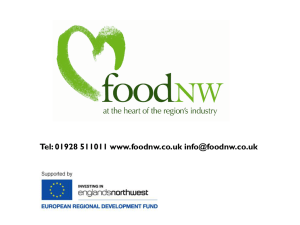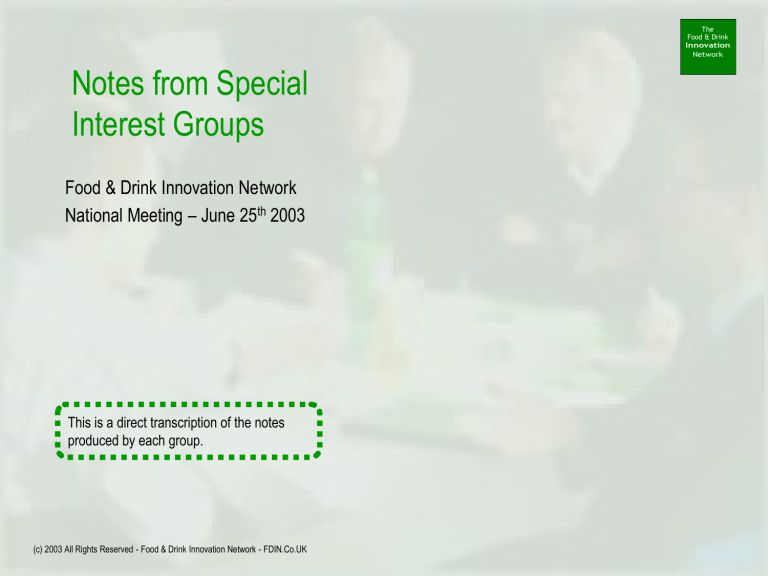
The
Food & Drink
Innovation
Network
Notes from Special
Interest Groups
Food & Drink Innovation Network
National Meeting – June 25th 2003
This is a direct transcription of the notes
produced by each group.
(c) 2003 All Rights Reserved - Food & Drink Innovation Network - FDIN.Co.UK
Summary of special interest groups
1.
2.
3.
4.
5.
6.
7.
8.
Cultural Change
Effective portfolio management ... What is the best way to implement?
What’s is the best way to get started with a paperless NPD System?
How can we ensure an NPD system is effectively implemented across all departments.
QSA Product Demonstration
How to persuade the CEO on the Return On Investment and other benefits of a good paperless
NPD system.
Is a common integrated product spec system THE FIRST BIG STEP?
How do we utilise the systems we already have?
(c) 2003 All Rights Reserved - Food & Drink Innovation Network - FDIN.Co.UK
The
Food & Drink
Innovation
Network
The
Food & Drink
Innovation
Network
Top issues by Table
Table 1
–
–
–
–
Table 3
How do you measure the benefits of
automation?
Standardisation of automated NPD
systems for retailers
Industry standardisation of data format.
Different systems, their lack of
interoperability.
–
–
–
–
–
–
•
•
Table 2
–
•
•
•
Integration of market research, new
product development, process
development.
Enabling paperless NPD in more
companies.
Buy in / support from other functions.
Visibility of workflow & project tracking.
Have a single NPD system ... Paperless.
Front end screening rigour
Enabling the complete value chain.
(c) 2003 All Rights Reserved - Food & Drink Innovation Network - FDIN.Co.UK
Multi discipline commitment to NPD process.
Improving our NPD process.
Involving all key people in a development
system.
How do you maintain simplicity when
developing an on line system.
Benchmarking other’s processes.
The
Food & Drink
Innovation
Network
Top issues by Table
Table 4
–
–
–
–
–
Table 5
Software that does what it’s supposed to
do.
Intuitive user-friendly system.
Understand what is really meant by a
paperless system.
User friendly, cope with numerous
projects, simplicity.
Ease of use in delivering for those out
there at the sharp end.
(c) 2003 All Rights Reserved - Food & Drink Innovation Network - FDIN.Co.UK
–
–
–
–
–
–
–
–
–
Improve cycle times.
Avoid duplication efforts.
Resource Allocation.
Paperless innovation.
Seamless Process.
Control of development process and
prioritisation of resources.
Resource Allocation
Speed to market
Paperless System
The
Food & Drink
Innovation
Network
Top issues by Table
Table 6
–
–
–
–
–
–
Table 7
How to manage the people aspects of
NPD
Find a computer system to reduce the
paperwork involved in development that’s
easy to use and for sharing information.
What are the latest NPD systems and are
they worth implementing?
Knowledge management ... Thousands of
raw materials available to use, hundreds
of separate “bytes” of data associated
with each RM. How to manage ... Tacit
and explicit.
Implementing a streamlined effective NPD
system.
To get a broad understanding of the
systems available so that e can offer
impartial advice on systems.
(c) 2003 All Rights Reserved - Food & Drink Innovation Network - FDIN.Co.UK
•
•
•
•
•
Understanding which system(s) suit our
business best.
Paper based NPD system that does not
work.
Implementation of paperless systems
throughout the supply chain.
One system (particularly technical and
specification) that fits all good business
throughout the chain.
Standardisation of product specifications
across retailers.
The
Food & Drink
Innovation
Network
Top issues by Table
Table 8
•
•
•
•
•
•
•
Table 9
Systems to manage new product
development.
How do companies manage their portfolio
(picking winners / losers) making better
go/ kill decisions.
Integrating effective knowledge capture
into paperless NPD systems.
Understand types of IT systems available.
Innovation Tunnel.
Overcoming the IT phobias of users.
Understanding more about NPD systems
to see how they can help me.
(c) 2003 All Rights Reserved - Food & Drink Innovation Network - FDIN.Co.UK
•
•
•
•
•
•
Organisational acceptance of moving
away from functionalist and control of
own destiny (e.g. using paper) towards
centralised and visible process.
Understanding customer needs and
solutions available.
Gaining senior management buy-in.
How to ensure the people management
issues of crucial to all NPD processes are
addressed.
Systems that facilitate NPD process and
don’t create electronic overload.
Integration of QSA with other specs /
paperless NPD
The
Food & Drink
Innovation
Network
Cultural Change
Attendees: Roy Jefferey – Manor Bakeries; Steve Kerzman - Consultant; Daniel Plowright – Brookes Avana;
Jennifer Epke - Somerfield; David Lomas – A G Barr; Zoe Nicholls – RHM Foodservice; Lisa WilkinsonHazlewoods; Annelise Whittaker – Golden West; Kate Stewart Cox – Perspectiv.
The challenge is to get people to embrace a new
system.
Explore ideas to sell the benefits.
1. Demonstrate under old system there is lots
of duplication of paperwork.
2. Need to avoid making human beings feel
processed.
3. Two types of business case. One for the
board – numbers focused. The other is for
the masses which is motivational.
4. Invest in the time to ensure all people are
briefed properly.
(c) 2003 All Rights Reserved - Food & Drink Innovation Network - FDIN.Co.UK
5.
6.
7.
8.
Take the people who won’t use it out of the
system.
One on one action to understand why they
won’t buy in.
Bring in professional communicators and
facilitated workshops!
Use external resources. This will help with
openness.
Effective portfolio management ... What is the best way to
implement?
The
Food & Drink
Innovation
Network
Attendees: Suzanne Trew – Scottish Courage; Sally Whelan – Concept To Launch; Fiona Jefferson- Marlow
Foods; Malcolm Austin – Golden Fry; Daniel Plowright – Brookes Avana; Roy Motteram – Master Foods; Andy
Wilkins - Perspective
Requirement for a gated process first. Then
introduce a scorecard at each gate.
Various criteria to be used as appropriate for
each company. E.g.
–
–
–
Strategic fit
Competitive context
Financial measures
Need to weight criteria and keep re-visiting
weighting to ensure decisions are
appropriate.
At post implementation review check that score
card delivered or else need to revisit.
Each scored project should then be compared
against all other live projects with a view to
ensuring that sufficient resource is available.
This might mean cancelling or putting on
hold projects previously that have been
previously given the go-ahead.
(c) 2003 All Rights Reserved - Food & Drink Innovation Network - FDIN.Co.UK
The cancelling of projects can cause major
people issues unless the core way in which
people are measured is changed.
Key questions / issues
–
–
•
How do we kill projects effectively?
How do we manage the people issues?
Group desire to work together on this topic
and share best practice.
What’s is the best way to get started with a paperless NPD
System?
The
Food & Drink
Innovation
Network
Attendees: Paul Clarkson S K Chilled Foods; Annelise Whitaker Golden West Foods, David Lomas – A G Barr, Malcolm Wilkes – MW Associates, Aileen
McLaughlin - Masterfoods, Michelle Beaton – Master Foods.
Questions
What do you do if the customer (retailer) has no
system ... How do you know where to start?
How do you generate the time to do initial set up?
Do any of these systems help manage “blue sky”
work?
(c) 2003 All Rights Reserved - Food & Drink Innovation Network - FDIN.Co.UK
Solutions / Comments
Don’t necessarily get bogged down with a
complete system. Maybe look at it on a
modular basis.
Can one of the providers produce a simple-entry
NPD process management system.
Can we (as manufacturers) have real input into
how a module is set up? Have a debate.
Could be two systems e.g. own label /
branded.
We need to get all processes in the business
aligned before trying to implement the
system.
The start up system needs to be not be labour
intensive or it will not get off the ground.
Need to get buy-in by all users at early stage.
How will it make their job easier.
How can we ensure an NPD system is effectively
implemented across all departments.
The
Food & Drink
Innovation
Network
Attendees: Emma Chambers – Concept 2 Launch; Zoe Nicholls – RHM Foodservice; Chris Wells – General Mills; Kate Stuart-Cox – Perspective; Tim
Winfield – QSA Product Vine; Tony Tompsett – Hall & Woodhouse; Derek Gale – Weetabix. Steve Kerman - Consultant
CEO Buy in crucial.
Design ownership from all departments – Design
your bit.
Sell in to each department.
In depth introduction ... Reasons why.
Systematic way to reduce paper.
Identify “savings” opportunities.
Allow sales etc to have an increased input.
vs. Remove daily sales input (Happy to
accept reduced work load) to allow
systematic prioritisation.
vs. make sales responsible for driving
system – good for own label
(c) 2003 All Rights Reserved - Food & Drink Innovation Network - FDIN.Co.UK
Prioritisation of ideas to develop may be a system
which is required for food.
Buy-in from factory manager? They can be
designed-in as being accountable.
Flow of “red ink” was the main thing that got
systems and new work styles moving in hitech ... Likely for food manufacture as well.
Good if system can manage de-lists this appeals
to production.
Benefit of starting to measure production based
on NPD aspects not just efficiencies.
Demonstration of new ideas needs to be
presented across all functions.
The
Food & Drink
Innovation
Network
QSA Product Demonstration
Attendees: Smith – Ledbury Preserves; Mike Shaw – Dairy Crest; Michelle Beaton – Master Foods; Jenny Epke – Somerfield; Susie Giles – Marks &
Spencer; Leo Guevera – Huddersfield University.
Des Smith
Similarities between find & PV (SSL).
Use PV for other systems and internal.
Mike Shaw
Understand how stage-gate process can be
managed through the system and workflow.
How to make paper system electronic.
Michelle Beaton
Business process analysis. ? Consolidate or
have differences.
Use different templates and how to get standard
approach.
Leo Guevarra
What is happening in industry and with product
development.
(c) 2003 All Rights Reserved - Food & Drink Innovation Network - FDIN.Co.UK
Based on these interests an overview of the
system was demonstrated.
How to persuade the CEO on the Return On Investment
and other benefits of a good paperless NPD system.
The
Food & Drink
Innovation
Network
Attendees: Kevan James - Karlshamns; Emma Chambers – Concept 2 Launch; Simon Shepherd - Consultant; Suzanne Trew – Scottish Courage; Jenny
Linnell - McCormicks, Debbie Calver - McCormicks, Sally Whelan – Concept 2 Launch.
Physically save time. Have a cheque list. No need to
back track.
Save money.
Increasing revenue / time to market.
More efficient and effective.
Not monitor.
More work / form filling (against system)
Short time span projects against structured system (i.e.
6 weeks)
Short term commercial successes override need for
system.
(c) 2003 All Rights Reserved - Food & Drink Innovation Network - FDIN.Co.UK
Drivers – Why paperless NPD system.
1. Competitive threat. (Competitor A has been
successful using X system)
2. Selling tool, endorsement of brand / company.
3. Benefits of cultural change.
4. Greater structure and accountability.
5. Team development.
6. Management planning (effective)
7. ROI – quicker to market / focus / more to market /
avoids duplication / saves money
8. Productivity improvement
9. Redeployment of human resources – more blue
sky more NPD
Benefits of collaborative working with suppliers and
customers.
Supply chain synergies (which create efficiency and
lower costs)
Better communication (Between companies /
departments)
Linked to individual departmental objectives and
Management objectives.
Is a common integrated product spec system THE
FIRST BIG STEP?
Attendees: David Moreton – Memory Lane Cakes; Angus Smith – Macphie of Glenbervie; Malcolm Austin – Golden Fry
1.
2.
3.
4.
Retailers reluctance to give up their own system.
Ingredients straight through the system from supplier to final spec.
Different templates at the moment.
The small ingredient suppliers do not have the resource to give the information as
required..
5. Make it easier for retailers to deal with smaller suppliers.
6. Could we add traceability to this system.
7. How do we make the case for the change attractive to retailers?
(c) 2003 All Rights Reserved - Food & Drink Innovation Network - FDIN.Co.UK
The
Food & Drink
Innovation
Network
How do we utilise the systems we already have?
The
Food & Drink
Innovation
Network
Attendees: Nick Williams – Sopheon; Derek Gale – Weetabix; Fiona Jefferson – Marlow Foods; Cathy Anderson – Cadbury Schweppes RSSL – Simon
Connolly – Sopheon; Simon Williams – Hygrade Foods; Matt Wall – Charteris PLC; Bob Anderson; Chris Wells – General Mills; Tony Tompsett – Hall &
Woodhouse PLC; Dave Hutchinson – The Duckworth Group.
Examples: SAP, Lotus, Access, Oracle.
Challenges
1. Workflow & Data Integrity.
2. Duplication of content
3. Lotus notes > change to Microsoft platforms.
4. Security, outside of company R & D.
5. Restriction of data to sections within the company.
•
6.
What basis to prioritise? Volume, margin, revenue.
•
7.
9.
Fill in forms; inform decision makers.
E-mail culture is big now. Integrate with e-mail.
•
8.
E-mail to overcome access to the system.
Dangers of work spam.
Practical implications of resolving priority;
demanding too much information can be an
annoyance.
Resource Constraints – Time allocation precious.
•
Tracking systems can distract, excel, list of people
and projects, works well in short / not long term.
Data Integrity
•
Potential to be optimistic. Human nature to favour
your own projects.
•
Benchmarking assumptions ... Logging data.
•
Who lead the NPD process?
•
Solutions can “block” the pipeline with lots of
products. Look at the critical path and inputting
data once.
Implementation
•
Starting off small then moving into full system.
Existing Systems
•
Utilising SAP with reports in Excel.
•
Opportunities for standardisation needs to be
driven by clients, or DTI (Attempt previously by
flavouring industry)
Moving Forward
Encouraged to use more people for change.
Leaving something with no means of support!
Collaboration
Global food development. Restrictions.
(c) 2003 All Rights Reserved - Food & Drink Innovation Network - FDIN.Co.UK


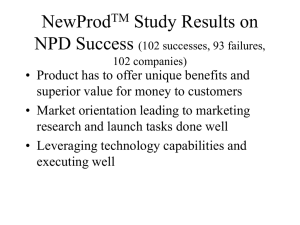

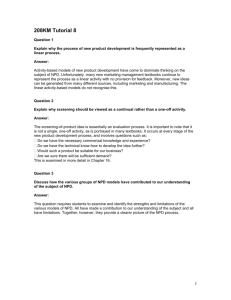
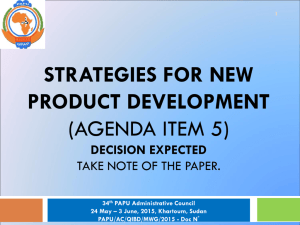
![Your [NPD Department, Education Department, etc.] celebrates](http://s3.studylib.net/store/data/006999280_1-c4853890b7f91ccbdba78c778c43c36b-300x300.png)

